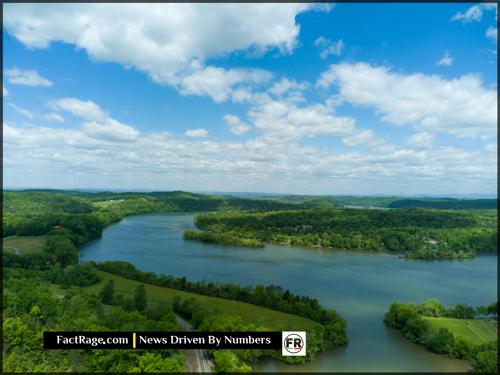TRAVIS COUNTY, TX – Unprecedented rainfall has sent the Guadalupe River surging over its banks, inundating homes and infrastructure across southern Travis County and triggering a massive, citizen-led rescue operation.
- Record Deluge – A severe storm system stalled over Central Texas, causing the Guadalupe River to crest at levels not seen in recorded history, flooding communities and overwhelming official resources.
- The ‘Cajun Navy’ Responds – A volunteer flotilla of private boat owners, famously known as the ‘Cajun Navy,’ has mobilized from Texas and Louisiana to assist in rescuing residents trapped by the high water.
- Strained Emergency Services – Local fire departments and emergency management officials report being stretched to their absolute limits, making the coordinated efforts of civilian volunteers essential to the rescue mission.
The dramatic rise of the floodwaters has been matched only by the remarkable swell of community and volunteer response, turning neighbors and strangers into first responders.
When the Water Rises Higher Than the Plan
![]() In a crisis, we expect official plans and emergency services to be the answer. But along the swollen Guadalupe River, the sheer scale of the flooding quickly outstripped any formal response, revealing a hard truth about modern disasters. When institutional help is overwhelmed, a much older American tradition takes over: the community becomes its own lifeline. The story of the ‘Cajun Navy’ in Travis County isn’t just about a weather event; it’s a powerful look at who really shows up when the water rises.
In a crisis, we expect official plans and emergency services to be the answer. But along the swollen Guadalupe River, the sheer scale of the flooding quickly outstripped any formal response, revealing a hard truth about modern disasters. When institutional help is overwhelmed, a much older American tradition takes over: the community becomes its own lifeline. The story of the ‘Cajun Navy’ in Travis County isn’t just about a weather event; it’s a powerful look at who really shows up when the water rises.
Read On…
How this volunteer flotilla operates on the ground, who makes up its ranks, and what their critical presence reveals about the state of disaster response in America.
What Caused the River to Rise So Fast?

The crisis began late last week as a slow-moving weather system dumped more than 20 inches of rain across parts of the Texas Hill Country in less than 48 hours. This deluge rapidly overwhelmed the creeks and tributaries that feed the Guadalupe River. By Saturday morning, the river had surpassed its major flood stage, and by Sunday, it had crested at a historic high, according to the National Weather Service.
The speed and volume of the runoff left little time for residents in low-lying areas to evacuate. Roads became impassable, power lines were downed, and entire neighborhoods were transformed into murky, fast-moving lakes. Local officials issued flash flood warnings and evacuation orders, but for many, the water rose too quickly, trapping them in their homes with no way out. The sheer scale of the inundated area quickly outstripped the capacity of local fire and rescue teams.
Who Are the Volunteers Answering the Call?
As emergency call centers were flooded with requests for help, a different kind of response was already underway. Convoys of pickup trucks hauling flat-bottom boats, airboats, and jon boats began arriving in the staging areas set up on the edges of the flood zone. These volunteers are part of the informal but highly effective network known as the ‘Cajun Navy.’
The name originated in the aftermath of Hurricane Katrina in 2005, when hundreds of Louisiana sportsmen and fishermen launched their own boats to rescue thousands of people stranded in New Orleans. Since then, these decentralized, self-organizing groups have become a common sight at major flooding events across the Gulf Coast and beyond. They operate without official command, using social media apps like Zello to coordinate rescue missions, share information on water conditions, and map out requests for help. Their members are not paid; they are carpenters, fishermen, oil field workers, and retirees who use their own equipment and fuel to save lives.
What Does the Rescue Effort Look Like on the Ground?
On the ground in Travis County, the scene is one of organized chaos. Official first responders from the Austin Fire Department and Travis County Sheriff’s Office are working to direct and integrate the volunteer efforts where possible, prioritizing the most urgent medical calls. Meanwhile, Cajun Navy teams launch into the floodwaters, navigating treacherous currents filled with submerged cars, fences, and other debris.
These volunteers are often the first to reach isolated homes, pulling families and their pets from second-story windows and rooftops. They bring water, supplies, and, most importantly, a ride to dry land. The effort is a testament to a deeply ingrained community spirit, forged in the shared experience of natural disasters. While the full extent of the damage is not yet known, the collaboration between official crews and civilian volunteers highlights a crucial reality of modern disasters: when nature is at its most destructive, formal systems often require the help of their own citizens to meet the overwhelming need.
An American Tradition of Neighborly Rescue
![]() The story of the ‘Cajun Navy’ in Travis County is not an isolated event, but another chapter in a long history of American self-reliance in the face of disaster. From prairie fires to past floods, the impulse for communities to organize and rescue their own is a deeply ingrained part of the national character. This modern flotilla, connected by smartphones but powered by an age-old sense of duty, proves that when the waters rise, the most reliable lifeline is often the one thrown by a neighbor.
The story of the ‘Cajun Navy’ in Travis County is not an isolated event, but another chapter in a long history of American self-reliance in the face of disaster. From prairie fires to past floods, the impulse for communities to organize and rescue their own is a deeply ingrained part of the national character. This modern flotilla, connected by smartphones but powered by an age-old sense of duty, proves that when the waters rise, the most reliable lifeline is often the one thrown by a neighbor.














